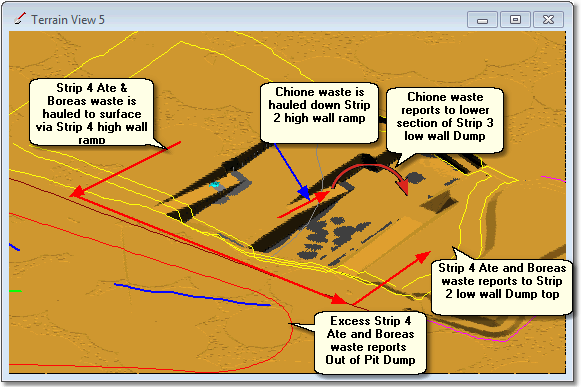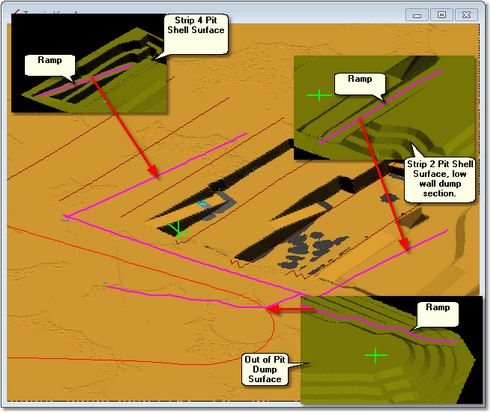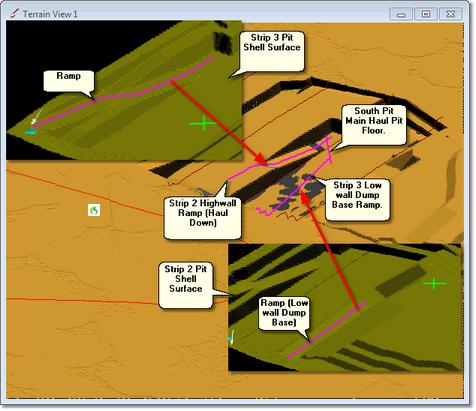In the previous exercises we have set up linked Staged Excavations and Staged Dumps. Our 3d-DigPlus file is now in a state with a set up which allows progressive excavation in a manner consistent with the proposed schedule, together with progressive dumping of all waste material excavated. In this exercise we will create a system of roads for use in a truck shovel simulation which will allow our Supersequence to model Truck and Shovel productivity.
Description of Road System.
The figure below illustrates the required movement of waste material from excavation point to dump:

Waste Material Movements.
The road requirements of the various waste passes are as follows:
Strip 4 Ate and Boreas waste:
This waste material must be hauled from the excavator to natural ground level at the Strip 4 northern end wall. From here it must be hauled along the line of the end wall to a point near the base of the Strip 2 Low wall Dump Top. Finally it must be elevated via a ramp to the current dump lift level of the developing Strip 2 Low wall Dump Top.
When the Strip 2 Low wall Dump Top is full, waste material will then report to the Out of Pit Dump. At this stage the haul path along the endwall must terminate near the toe of the access ramp for the Out of Pit Dump. From here material must be hauled up a ramp to the current lift level of the developing Out of Pit Dump.
These hauling requirements can be met with the following 3d-DigPlus Roads:
Main Haul Road North. This road will run along natural ground from a point near the Strip 4 highwall crest to a point just beyond the toe of the ramp of the Strip 2 Low wall Dump Top. For Strips 1 to 3 the highwall ramps join the topography at natural ground level at the end wall crest. However from Strip 4 onwards the Main Haul Road must be excavated in the end wall with each Strip excavation. This is due to the fact that the overall overburden thickness increases and there is insufficient run along the highwall to elevate the trucks to natural ground level at 10%. The following figure, which depicts the overall pit shell illustrates this:

South Pit Shell, Showing Main Haul Road along Northern End Wall.
Strip 4 Highwall Ramp. This road will be used as the Excavation Access Road. It will connect with the Main Haul Road North and ramp down at 10% to the current lift of the Strip 4 excavation. The Strip 4 Pit Shell Surface incorporates this highwall ramp. Therefore as excavation proceeds down the ramp will emerge in the evolving topography. The Horizontal Alignment for this road will run approximately down the centreline of the ramp in the Pit Shell surface. On the endwall side it will extend far enough to join or just cross over the Main Haul Road North. The Vertical Alignment of this road will be placed approximately along the natural ground level beyond the end wall, then follow the ramp in the Pit Shell Surface. Note that this alignment will be placed approximately, and it should not be placed significantly below either the natural surface beyond the end wall, or the ramp within the region of the Pit Shell Surface. (see Excavation Access section of User Manual). When this Road is used in a Truck Shovel Simulation it will be used in Haul Up mode.
Strip 2 Low wall Dump Top Ramp.This road will link the end of the Main Haul Road North to the current lift of the Strip 2 Low wall Dump. The Strip 2 Pit Shell Surface, which includes the surface of the Strip 2 Low wall Dump, incorporates this spoil ramp. Therefore as dumping proceeds up in lifts the ramp will emerge in the evolving topography. The Horizontal Alignment for this road will run up the centreline of the ramp in the Strip 2 Pit Shell Surface. On the endwall side it will extend far enough to join or just crossover the Main Haul Road North. The Vertical Alignment of this road will be placed approximately along the natural ground level beyond the end wall, then follow up the ramp in the Pit Shell Surface. Note that this alignment will be placed approximately, and it should not be placed significantly above either the natural surface beyond the end wall or the ramp within the region of the Pit Shell Surface (see Dump Access Roads section of the User Manual).
Out of Pit Dump Ramp.This road will link the end of the Main Haul Road North to the current lift of the Out of Pit Dump. The Out of Pit Dump Surface incorporates this spoil ramp. Therefore as dumping proceeds up in lifts the ramp will emerge in the evolving topography. The Horizontal Alignment for this road will run approximately up the centreline of the ramp part of the Out of Pit Dump Surface. Beyond the Out of Pit Dump Surface this road will extend far enough along the natural topography to join the Main Haul Road North. The Vertical Alignment of this road will be placed approximately along the natural ground level beyond the end wall, then follow up the ramp in the Out of Pit Dump Surface. Note that this alignment will be placed approximately, and it should not be placed significantly above either the natural surface beyond the end wall or the ramp within the region of the Pit Shell Surface.(see Dump Access Roads section of the User Manual).
The figure below illustrates these Roads. In this figure a thumbnail of the relevant Pit Shell and Dump surfaces is shown illustrating the location of the ramps in these surfaces and also the ramp location on the topography:
Strip 3 Chione waste.
This waste material is to be placed in the Strip 3 Low wall Dump Base. This dump will be empty at the time the Strip 3 Chione waste reports to it. Consequently haul distance is an elevation will be small. Waste material will be hauled down the remaining portion of the Strip 3 highwall ramp, it will then be hauled short distance across the pit floor before being elevated via a ramp in the Strip 3 Low wall Dump surface. the Strip 3 Pit Shell incorporates the surface for the Strip 3 Low wall Dump, this surface incorporates the ramp.
These hauling requirements can be met with the following 3d-DigPlus Roads:
Strip 2 Highwall Ramp in Haul Down mode. Material for the current Strip 3 Chione waste lift will be hauled down the remaining portion of the Strip 2 highwall ramp to the pit floor. This ramp exists in the Strip 2 Pit Shell and this will be used to set the Vertical Alignment for the road. As trucks will be required to join this road at an elevated point and then descend down to the told the ramp, this ramp will have to be set to operate in Haul Down mode. The Haul Down mode is not set during the creation of the road, but is set when the roads are assigned to Subsequences. This task is performed in the following topic.
Strip 3 Low wall Dump Base Ramp. The Strip 3 Pit Shell includes the low wall profile which incorporates the constraining surface for the Strip 3 Low wall Dump. This surface incorporates and access ramp running up the down dip side of the dump. Therefore as dumping proceeds up in lifts the ramp will emerge in the evolving topography. Dump Access Road will be established to model this ramp. The Horizontal Alignment of this road will run down the centreline of the ramp in the Strip 3 Pit Shell. The Vertical Alignment for this road will match the alignment in the Strip 3 Pit Shell Surface.
South Pit Main Haul Pit Floor. Main Haul road must be set up to connect the Strip 2 highwall ramp the Strip 3 Low wall Dump Ramp. The Horizontal Alignment for this Road will connect the toes of the two ramps.
The figure below illustrates these roads. In this figure a thumbnail of the relevant Pit Shell and Dump surfaces is shown illustrating the location of the ramps in these surfaces and also the ramp location on the topography:
Topic Tasks
The tasks for this topic involve creating a set of Haul Roads. All of the Excavation Access and Dump Access roads follow the alignment of roads which exist in various Excavation and Dump surfaces. In all cases a Surface Feature exists in the relevant surface which runs along the ramp centreline. In each case the first task in creating the Road is to open a window to the relevant Surface, copy this Surface Feature, and paste it onto the topography. The feature than acts as a guideline when placing the Horizontal Alignment for the Road.
Note that in order to facilitate the rapid design of Roads, the placement of Horizontal and Vertical Alignments in 3d-DigPlus only needs to be approximate. In this exercise we will use surface features as a guide for creating Horizontal Alignments, and Inner Surfaces, in section view, as a guide for creating Vertical Alignments. These alignments only need to be placed in a manner that approximately conforms to these guides. However with Excavation and Dump Access Roads (ramps), it is important to keep in mind the mechanism used by 3d-DigPlus to determine the toe/crest of these roads (ramps) at the current excavation or dump lift. This subject is covered in the User Manual topics Excavation Access Roads and Dump Access Roads. and is just presented briefly here. The mechanisms are:
Excavation Access Road. The Vertical Alignment for the Excavation Access Road follows the ramp in the final excavated surface. Therefore at a point when the excavation is part way down, the Vertical Alignment will follow the current topography down to the level of the current lift. Beyond this lift the Vertical Alignment follows the final ramp surface below the current lift level. 3d-DigPlus determines the toe of the ramp for the current lift by establishing the point where the Vertical Alignment ceases to be on the topography and moves below the topography.
Dump Access Road. The Vertical Alignment for the Dump Access Road follows the ramp in the final dump surface. Therefore at a point when the dump is part way up, the Vertical Alignment will follow the topography up to the level of the current dump lift. Beyond this lift the Vertical Alignment follows the ramp surface above the current lift level. 3d-DigPlus determines the crest of the ramp to the current lift by establishing the point where the Vertical Alignment ceases to be on the topography and moves above the topography.
In order for the above process is to work, the Vertical Alignment must be placed close to the alignment of the ramp in the final excavated/dumped surface. If for example, the Vertical Alignment for a Excavation Access Road is substantially below the level of final excavated surface, then 3d-DigPlus will not be able to correctly establish the toe of the current lift. Instead this toe will be deemed to be at a point where the Vertical Alignment is first significantly below ground. 3d-DigPlus does apply at a small threshold, so if the actual Vertical Alignment is slightly below ground in the case of the Excavation Access Road, or slightly above ground in the case of the Dump Access Road the process will still work.
This topic involves creating all the roads necessary to to add a Truck and Shovel simulation to the Supersequence and Dumps created in previous exercises.The tasks of creating the various Roads are explained over several video clips. To commence the the exercise with the first video clip load one of the two files:
•Topic 11 Complete.3dd, this is the last file is saved if you have completed the topic Assigning Dumps to Subsequences for Strips 3 & 4.
•Topic12_Start.3dd, this is the supplied file which is at the equivalent state to the file mentioned above.
User Manual Topics for tasks covered in this Topic.
Setting up Haul Roads and Accesses.

